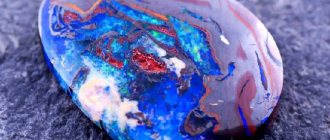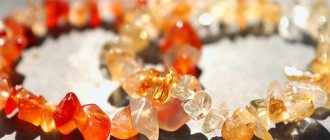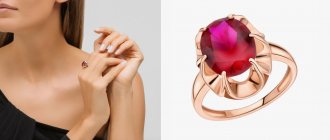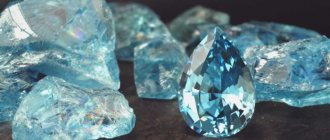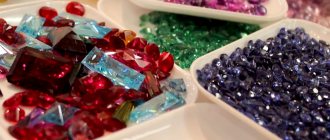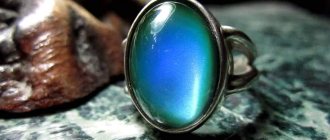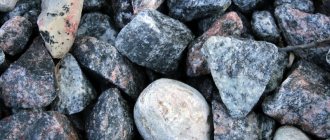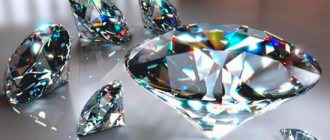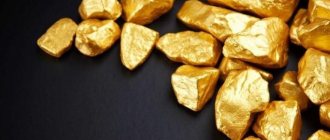A stone that changes color is mysterious and attractive. It suits the same changeable natures, which coincide with the mineral in energy and change with it. This is the mineral of flexible and free people who are ready to experiment and have a subtle sensitive nature. Such minerals are also called alexandrite effect stones, after the name of the most famous stone - the chameleon. They are united by one common property - these are precious, semi-precious stones with crystal transparency.
Chameleon stones and their properties
Stones that change color have three varieties:
- Stones with alexandrite effect or reverse effect. Change depending on lighting and other influences.
- Stones with pleochroism. Change color depending on the observation point.
- Dichroism. Slight color variation in two shades.
The most beautiful and mysterious stones are chameleons, with a reverse spectrum:
- Amethyst. A type of quartz. Depending on the deposit, it comes in different colors - from lavender to deep purple. Lavender amethyst turns pale when exposed to bright light or heat. As air humidity increases, the stone darkens. Can serve as a weather indicator - indicate the approach of thunderstorms and rain. Dark amethyst is good in daylight, in the evening it fades and ceases to show deep color shades.
- Alexandrite, the royal gem. It has a deep, multi-faceted color. The stone changes along with the light rays. Ultraviolet gives the mineral olive and emerald shades. Evening lighting darkens the stone and gives it dark purple and even violet colors. At dusk, the mineral flashes with scarlet highlights and can become the color of ripe raspberries.
Alexandrite
Real alexandrites are mined in Africa, Brazil and India. They are rare and expensive. Brazilian alexandrite varies in color from pink to sea green. African color changes from yellow-pink to green. Indian is closer in color to Brazilian, but much lighter.
- Aquamarine, a type of beryl. The color spectrum depends on the lighting. A unique mysterious stone, its color is fluid like water. The mineral shimmers from milky blue to green, flashing from the depths with golden sparks. In bright light the stone becomes almost transparent. Changing light throughout the day transforms the stone, causing it to play with different colors.
- Garnet is a pyrope. During the day, the stone plays with shades of green and purple. With the onset of dusk it becomes wine-red, by night it becomes almost black with cognac sparkles.
- Sultanite. By nature it is endowed with mysterious tints of yellow, emerald, pink and purple. It changes with the lighting. In bright sun it turns cognac yellow, and at dusk it darkens to purple. Under artificial light it will turn green. This is a rather rare stone, which is now mined in Turkey. The natural mineral has a green base color.
- Corundum. It includes sapphires and rubies. They change when heated, becoming brighter and darker. African blue sapphire can react to artificial light by appearing purple.
- Tourmaline. It comes in pink, green, emerald and yellow. If it is pink during the day, it turns brown in the evening. Green tourmaline will turn red in artificial light. Reacts to high temperatures. This property is used by jewelers who transform the natural color into a deeper one.
- Iolite A semi-precious mineral that changes shades in one color spectrum: from violet to bright blue.
- Topaz is a weak chameleon. It brightens greatly in bright light, becoming almost transparent.
- Citrine changes in the yellow spectrum. Can be lemon and orange.
- Ametrine is a plechroic stone, but also reacts to light. This is a light pink-green crystal. Under the bright sun it becomes light and loses its shades.
- Blue apatite has a strong alexandrite effect. Under artificial light it turns yellow-green.
- Chrome diopside is capable of turning from yellow to green.
- Tanzanite reacts to light by changing its color from blue to brownish green.
- Zircon changes color when heated. Yellow stones take on different shades of blue. Heliodor has the same property.
- Blue spinel has an alexandrite effect. Under artificial light it turns purple.
- Fire opal is colored in bright red-orange and bluish-yellow colors. Opals from Mexican deposits have iridescent highlights.
Tourmaline
Opal reacts to changes in humidity. A blue stone turns orange in the rain, and a red stone turns yellow. If the air simply becomes more humid, the color change will be less intense.
Terminology
The natural ability of minerals to change their initial color is officially called differently:
- The effect of pleochroism or simply pleochroism (multicolor). The ability of a mineral to change color when light is reflected in different directions. That is, when turning or from a different viewing angle, the color of the stone is different.
- Alexandrite effect. Changes in the color of a mineral under different lighting (daytime, twilight or artificial). The second name is color reverse. Jewelers operate with it, implying the property of crystals to change color only under artificial light. Its depth is measured as a percentage: the greater, the more expensive the gem.
At the everyday level, any such stone is called a “chameleon”.
Only natural minerals have the listed properties, not synthetic ones.
The color of the stones and the mood of the owner
The pomegranate reacts to the owner’s mood. It is a kind of indicator of the owner’s energy. The stone patronizes strong and integral natures that have positive energy. He plays with them with red rays. When a person is tired, weak or sick, the garnet becomes dull. He helps the owner, taking the negativity onto himself.
Aquamarine also senses human energy. If he feels angry, the stone becomes cloudy. It fades if it feels sad and depressed.
Chameleons cannot harm their owner. They strive to help, adapting to the needs of the owner. Playing with green flowers, they try to calm a person and give him vitality. Going into the red spectrum, the stones set you up for passion and activity, helping to attract the opposite sex.
Aquamarine
It is no coincidence that in the evening the color of the stones becomes deeper, tuning in to sensual experiences.
Jewelry
Alexandrite fits perfectly into the jewelry world. Jewelry with gemstones looks chic and majestic. Large crystals are rarely used in jewelry. Valuable large specimens mainly end up in state gem museums or in rich private collections.
Jewelers love to combine alexandrite with diamonds. These precious stones harmonize perfectly with each other, enhancing the brilliance and grandeur. Exclusive inserts framed in gold make the decoration truly royal.
Gold necklace with alexandrite and cubic zirconia (go to the SUNLIGHT catalogue)
Alexandrite works well next to pearls. The delicate shimmer of pearls only emphasizes the richness of color and brilliant shine of the precious crystal.
Products with alexandrite are easy to care for. The crystal is quite durable and strong. For a long time it does not lose its original appearance, shine and gloss. It is enough to sometimes wipe it with a velvet rag and store it in a separate box.
Who is suitable for volatile minerals?
If we talk about compatibility by zodiac signs, then alexandrite is suitable for the water element. Flowing water itself likes to change its color, and the mineral suits these signs in terms of energy. Opal has similar compatibility with water signs.
Amethyst helps Libra, Aquarius and Gemini. Does not coincide with the energies of Taurus and Leo.
Chameleons are suitable for water and air signs. They are not calm by nature, just like a chameleon can change their mood during the day.
For earth signs, chameleons can serve as agents for change. These signs are too rigid, so stones that change color will promote flexibility.
Esotericists believe that volatile minerals help to collect missing energy or remove excess energy. The stone senses what the owner lacks and corrects it.
Opal
This stone, with its variability, changes its owners. It should be worn only by righteous and creative people, since in this case it will help them realize their plans. Adventurers by nature, after wearing opal for a long time, can go to great lengths. The stone patronizes Pisces and Scorpios. The uniqueness of opal is that it changes color not only under sunlight, but also when in contact with liquid.
In ancient times, opal was used to treat various ailments:
- consequences of stress;
- infections;
- heart pathologies;
- insomnia.
Healers recommended wearing opal amulets for lovers so that their feelings would be preserved for many years. The crystal also eliminates damage and negative energy. There is a belief that opal should only be worn in pairs. Therefore, an even number of crystals should be used in a piece of jewelry, along with rock crystal and other minerals.
How to care for chameleon stones?
Minerals can lose their luster if not cared for. To restore brightness, you need to periodically do the following:
- Wash the jewelry or stone in warm soapy water. Do not use washing powder. The frame should be cleaned with a toothbrush to remove dirt.
- You can polish the mineral with a piece of suede or flannel.
Chameleons must be stored correctly and the operating rules must be followed:
- Each gem must be stored in individual packaging. If there is no box, a bag made of natural fabric will do.
- Stones should be protected from bright sun and high temperatures. You cannot wear them in the sauna, place them in direct sunlight, or sunbathe in them on the beach.
- The use of cosmetic creams and perfumes is incompatible with the presence of jewelry. Skin care and perfume application should be done while the jewelry is not yet worn.
- When using a hairdryer, high temperatures can have a negative effect on the earrings. It is better to remove them for a while.
- Before cleaning, jewelry must be removed.
- Do not drop stones or expose them to chemicals.
Chameleon stones are capable of changing themselves and changing their owner. You can coincide with them or not share their energy. You can understand this only by trying to carry a stone.
You can believe in esoteric properties or simply admire the transformations in the color of crystals. In any case, wearing a stone that changes color will bring pleasure to its owner.
Corundums
This is a whole group of crystals that, to one degree or another, have the property of changing shade. The most famous and durable corundum is diamond, but sapphires and rubies are more prone to discoloration. At the same time, their color reverse appears only in the sun, since heat and ultraviolet participate in the change in shade.
The entire group of corundums also has healing properties. Wearing them allows you to:
- get rid of nightmares;
- balance the psycho-emotional state;
- normalize blood pressure;
- strengthen blood vessels.
Distrustful and mocking people should not wear corundum. They are well suited to strong and bright natures. These stones are perfect for Cancers, Aquarius and Pisces. They are the patrons of these signs. The choice of mineral should also be made based on the profession of the wearer. Diamonds and other corundums are recommended for businessmen, entrepreneurs, and students. They can bring material success and stability to knowledge workers.
Fourth K: Carat Weight
The weight of gemstones is measured in metric carats, where five carats equal one gram. Typically, as the weight of a gemstone increases, so does the price per carat, a relationship that has long been known and was first identified by Villafane in 1572 for diamonds. Today it is most often referred to as "Indian Law" or "Taverner's Law" and works as follows:
Wt2 XC = stone price
Stone weight = 5 carats (Wt)
Price per carat of equivalent stone = $1000(C)
5x5x1000 = $25,000 total stone price
Below is how the price of a stone could increase using this formula using a base price of $1,000 per carat
| Carat weight | Cost of stone, $ |
| 1 | 1 000 |
| 2 | 4000 |
| 3 | 9000 |
| 4 | 16000 |
| 5 | 25000 |
| 10 | 100000 |
Unfortunately, things are not that simple, even for diamonds. The formula cannot accurately predict the price of a diamond below 1 carat, and there are also problems with exceptionally large stones. But this gives a general idea of how prices increase as the size of the stone increases.
Carat psychology
Many gemstones, including ruby and sapphire, experience a psychological (but all too real) price jump from a certain weight. For example, a 0.99-carat ruby can cost significantly less than a 1.05-carat stone. A 1.05 ruby would be worth more than a stone that weighs exactly 1,00 carats. Repolishing a 1.00ct stone (or weighing it on a different scale) can send it below the all-important 1ct barrier. Similar psychological barriers to a jump in price are at the level of 2, 5, 10, 20. 50 and 100 carats.
The picture above shows the relationship between price and quality/weight/rarity. Note that the graph is nonlinear.
Improvement
The term "enhancement" refers to special methods of treating stones that improve its appeal (color, clarity, performance), durability, price and suitability. Now there are quite a lot of stones on the market that have been improved by various methods, from the simplest, say, heating tanzanite, to high-tech, like the irradiation of blue topaz.
Natural, untreated stones are generally more expensive than treated stones of the same quality. Since processing greatly affects the price, the buyer should know complete information about the stone.
Amethyst - mystic
Almost any precious, semi-precious, and even non-precious stones have magical and mystical properties. If you look at the shimmering edges of precious stones for a long time, you can plunge into a state of trance and peace. Amethyst also has these features. This stone does not carry any bad energy. Queens and first ladies wore it with pleasure.
The magic of stones is in their beauty and shimmer

